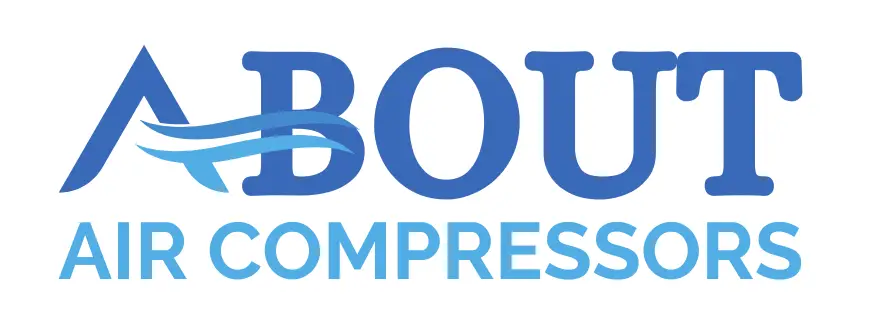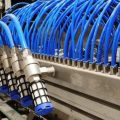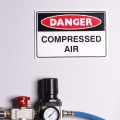Hey! This site is reader-supported and we earn commissions if you purchase products from retailers after clicking on a link from our site.
Regulators are used to lower air pressure to an air using application. Sandwich regulators are devices to enable rapid regulator installation so that air pressure to different actuators on a machine can be modulated as needed. This page offers more information about sandwich regulators.
Sandwich regulators are designed to be used with either sub-based or manifold-based compressed air valves.
As an example, let us say we build an air valve assembly with ten 4 ported, two position valves, and each one of these valves is controlling a double acting air cylinder.
Some of those air cylinders will need the pressure to them regulated, so that we can adjust the cylinder force on the extend stroke, and also on the retract stroke.

This could be a valve / cylinder plumbing nightmare.
Nightmare Cylinder Plumbing
We cannot just regulate air pressure to the air line that supplies the entire assembly of sub-based or extruded manifold based valves, as that regulator can only adjust the pressure to all the valves at the same time. And, every cylinder would have the same pressure and force on the extend and retract. We do not want that.
An in line pressure regulator installed in the line between the air valve and the cylinder is not an option, as in-line regulators are built to have unidirectional air flow. Install one in line between the valve and the cylinder and yes, it will regulate the air pressure to that end of the cylinder, but when the valve shifts and air now has to exit the line with the regulator in it, the air cannot exhaust properly as the regulator will restrict the flow.
Yes, we could install quick exhausts in each of the cylinder ports, so that the exhausting air could escape right there, and not try to flow back through the in-line regulator. That would be 20 quick exhausts we would need to plumb.
And, for our hypothetical bank of 10 air valves and 10 air cylinders, we would also have to install 20 in line regulators to achieve our goal of being able to adjust the force of the stroke of each cylinder in both the extend and retract action.
Yikes!
The solution is, of course, the sandwich air regulator.
Sandwich Regulators Make Installation Easy
By selecting a valve type that offers sub-based or manifolded valves that are configured to use a sandwich regulator, a sandwich regulator could be easily installed by removing valve from the sub-base or the manifold – usually by removing two or three bolts running through the valve from the top and into the base. Place the sandwich regulator on the base or manifold, being careful that the gasket that came with it is properly positioned between the regulator and the base. The valve will then sit on top of the regulator, and the gasket that originally sealed the valve to the base, will now seal that valve to its sandwich regulator.
The sandwich regulator package will normally include bolts long enough to travel through the air valve, through the regulator, and into the base. I suggest that you do not toss out the original bolts. They will come in handy in future should you wish to remove the regulator for any reason.
Sandwich air regulators typically have their pressure adjustment knobs at one end, and when a number of them are installed on the same valve bank, the adjusting knobs will all be at the same end, allowing quick and easy adjustment of the air pressure for each cylinder, on both the extend and retract strokes.
Regulator Gauges
All sandwich air regulators will either come with an external air pressure gauge, or, have a port into which you can install your own. Some sandwich regulators come with air gauges built right in, too.
Accuracy of the sandwich regulators, by and large, is of the general purpose regulator variety meaning that, when working properly, they will reliably hold the pressure within a 2-5 PSI range. I suspect that you can request a higher tolerance sandwich regulator from the manufacturer, should you have the need.
Each sandwich regulator will be unique to the company that builds the regulator and the air valve into which it sandwiches. Sandwich regulators are, to the best of my knowledge, not interchangeable with other valve brands.
In the event that you have a sandwich flow control installed between the valve and the manifold or sub-base, the sandwich regulator would normally be installed between the valve and the flow control. Be extra careful installing the variety of gaskets that these assemblies will are equipped with.
When you purchase the sandwich regulator for a specific air valve brand, it should come with sufficient bolts long enough to span the valve, regulator and sandwich flow control combined, but better check to be sure! The correct bolts may be difficult to source elsewhere. Check and make sure they come with the kit.
Additional valve reading:
- Types of Compressed Air Valves – Guide To Pneumatic Valves
- Pneumatic Flow Control Valves – What Are They, How Do They Work?
- Air Compressor Air Line Non-Return valves/Inline (In The Air Line) Air Check Valves Explained
- Check Valve Sizes
- What is Check Valve Cracking Pressure
- Air Compressor Troubleshooting Check Valve
- Air Compressor Unloader Valve Explained
- Unloader Valves On Twin V Piston Compressor Guide
- 5 3 Valves Explained
- 5-2 Air Valves
- 4-2 Compressed Air Valves
- 3-2 Air Valves
- Drawing a 5/3 compressed air valve
- Draw A 5/2 Air Valve
- Pneumatic Soft Start Valves
- Solenoid Pilot Air Valves
- Compressed Air Solenoid Valve Guide
- Air Compressor Auto Drain Valves Guide
- Needle Valve vs Ball Valve
- Globe Valve vs Ball Valve
- Globe Valve vs Gate Valve
- Butterfly Valve vs Gate Valve
New comment? New question? Please add it here, along with photos, to help others help you with your compressor and equipment problem!





